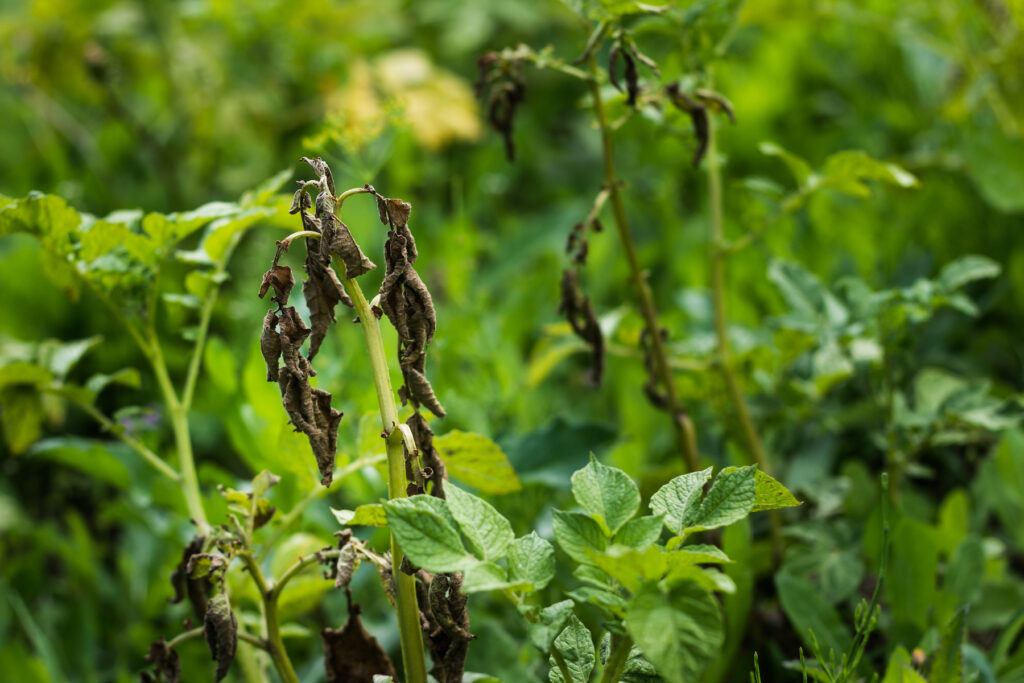How to tackle late blight after an unusually wet summer
21st August 2023
Outbreaks of late blight are springing up in potato crops across the country following an unusually wet July and early August. Fortunately, EU_43_A1 has yet to be found in the samples analysed, but growers must remain vigilant.
There has been a significant rise in blight outbreaks nationwide, after the UK had 170% of its usual July rainfall – making it the wettest July since 2009 and the sixth wettest on record, according to the Met Office.
The Fight Against Blight monitoring service, run by the James Hutton Institute, has reported 120 crop outbreaks to the middle of August. This puts 2023 on track to be a high-pressure year alongside 2019, 2012 and 2007.
The outbreaks are spread around all potato-growing regions, with typically drier areas like East Anglia having no respite.
EU_43_A1 a “big concern”
“It has been a challenge to keep on top of the samples coming into the lab,” says Dr David Cooke, research leader at the James Hutton Institute.
“We receive samples of fresh lesions, isolate and characterise the sample. We also do DNA analysis on what we receive. The aim is to spot any changes in the blight population as the season progresses so that spray programmes can be adapted based on the present genotypes.
“EU_43_A1 is our big concern because it is resistant to the carboxylic acid amide (CAA) group of fungicides, which includes mandipropamid. The key finding from our work so far this season is that we have not yet found it. We plan to conduct fungicide sensitivity testing on the 2023 isolates in the coming weeks”.
Even though EU_43_A1 has not yet been found this season, that does not mean the blight risk is low because 36_A2 is one of the dominant strains, cautions David. It has been present for a few years and is very aggressive, which poses challenges if it takes hold in a crop.
“Use chemistry wisely”
“Trying to firefight blight is very difficult, but the chemistry must continue to be used wisely, especially concerning the longer-term risk of EU_43_A1. We do not want other actives struggling under high pressure being misused. It is tempting for growers to keep using the products that will give them the best control, but they must use a range of fungicides.
“The good news is that the canopy has finished growing, so at least when a fungicide is applied, it protects all the leaves for a period. I would encourage growers to keep an eye on the lower canopy to ensure there is no residual amount of blight there. This could be the case following frequent heavy rainfall, which will spread the disease down the canopy,” advises David.
The worry is that the conditions have also suited tuber infection from any foliar blight established in the crop. Lower temperatures will encourage the production of zoospores, and combined with soil moisture, there is a high risk that if foliar blight remains unchecked, it will quickly become an issue in the soil.
Top tips for tackling blight
“We should now be mid-way through blight programmes with most crops at the canopy complete stage,” says UPL’s potato technical expert, Geoff Hailstone. “When outbreaks are found in the field, the priority must be to clear these up and stop them spreading as soon as possible. Where this is the case, Proxanil (cymoxanil + propamocarb) should be included in a tank mix.
“Cymoxanil is known to be one of the few actives with kickback activity and has a very low risk of developing resistance. Propamocarb has strong anti-sporulant activity, good movement in the plant and is only active in the carbamate resistance group.
“When tank-mixed with a protectant fungicide such as cyazofamid, Proxanil strengthens the activity and gives excellent resistance management. Where blight appears in the crop, there should ideally be two closely timed sprays, but growers must ensure that label intervals are adhered to,” cautions Geoff.
If foliar blight is active in the canopy, especially if conditions are favourable for zoospore production, then the risk of resistance developing can be particularly high.
“I would recommend continuing to include mancozeb for resistance management and to protect uninfected leaves. Although mancozeb only has protectant activity, it still has a role in controlling outbreaks when mixed with curative products. Mancozeb is sold as a straight product in Manzate 75WG or formulated with cymoxanil in Nautile DG (cymoxanil + mancozeb).
“Hopefully, the weather turns more settled until harvest, and growers can keep on top of disease in their potato crops, but they must maintain blight programmes until the foliage and stems are dead. Where a grower knows that foliar blight has been present in the crop, they should study the susceptibility to tuber blight of the variety they are growing and prioritise harvest accordingly,” concludes Geoff.


